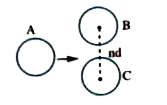A particle of mass m having collided a stationary particle of mass M deviated by an angle whereas the particle M recoiled at an angle to the direction of the initial motion of the particle m. How much in percent and in what way has the kinetic energy of this system changed after the collision, if M/m = 5 ?

The correct Answer is:
Topper's Solved these Questions
- COLLISIONS BOOK - AAKASH SERIESCHAPTER - COLLISIONS EXERCISE - QUESTIONS FOR DESCRIPTIVE ANSWERS
4 Videos
- COLLISIONS BOOK - AAKASH SERIESCHAPTER - COLLISIONS EXERCISE - NUMERICAL EXERCISE ( LEVEL 1)
18 Videos
- CENTRE OF MASSBOOK - AAKASH SERIESCHAPTER - CENTRE OF MASSEXERCISE - ADDITIONAL PRACTICE EXERCISE (PRACTICE SHEET (ADVANCED))
3 Videos
- ELASTICITYBOOK - AAKASH SERIESCHAPTER - ELASTICITYEXERCISE - Questions for Descriptive Answers
10 Videos
Similar Questions
A particle of mass m having collides with a stationary particle of mass M deviated by an angle π/2 whereas the particle M recoiled at an angle θ=30∘ to the direction of theinitial motion of the particle m. How much in percent and in what way has the kinetic energy of this system changed after the collision, if Mm=5.
View SolutionA particle of mass m having collided with a stationary particle of mass M deviated by an angle π/2 whereas the particle M recoiled at an angle θ=30∘ to the direction of the initial motion of the particle m. How much (in per cent) and in what way has the kinetic energy of this system changed after the collision, if M/m=5.0?
View Solution
Knowledge Check
A particle (A) of mass m1 elastically collides with another stationary particle (B) of mass m2. Then :
Am1m2=12 and the particles fly a part in the opposite direction with equal velocities.Bm1m2=13 and the particles fly apart in the opposite direction with equal velocities.Cm1m2=21 and the collision angle between the particles is 60∘ symmetrically.Dm1m2=21 and the particles fly apart symmetrically at an angle 90∘A particle of mass 2m moving with velocity v strikes a stationary particle of mass 3m and sticks to it . The speed of the system will be
A0.8vB0.2vC0.6vD0.4vA particle of mass m collides with a stationary particle and continues to move at an angle of 45∘ with respect to the original direction. The second particle also recoils at an angle of 45∘ to this direction. The mass of the second particle is (collision is elastic)
AmB√2mCm√2Dm2
A particle of mass m collides with a stationary particle of mass M and deviates by an angle of 60°. After collision mass M recoils at an angle 30° to the original direction of motion of m. If there is no loss in kinetic energy in the collision, the ratio of mM is _________.
View SolutionA particle of mass 2m moving with velocity v strikes a stationary particle of mass 3m and sticks to it . The speed of the system will be
View SolutionA particle of mass 2m moving with velocity v strikes a stationary particle of mass 3m and sticks to it. The speed of the system will be
View SolutionA particle of mass m collides with a stationary particle and continues to move at an angle of 45∘ with respect to the original direction . The second particle also recoils at an angle of 45∘ to this direction . The mass of the second particle is (collision is elastic )
View SolutionA particle of mass m moving with velocity v strikes a stationary particle of mass 2m and sticks to it. The speed of the system will be.
View Solution
